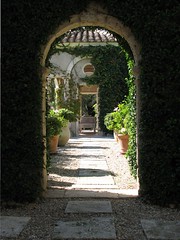Now that we understand that our gardens can be a venue for all manner of activity, how to we design our gardens accordingly. Seating areas are always important - veritable rooms can be created outdoors, complete with walls if desired. Segmentation of even a small garden space can make it seem larger than before. Having space that are unseen until one arrives in them adds a pleasant surprise. Plus more than one person can feel 'private' in the same garden.

A paved generous pathway
between two garden rooms.
Le jardin provençaux de Pierre Bergé
between two garden rooms.
Le jardin provençaux de Pierre Bergé
Paved surfaces, preferably permeable, also help create the room-like quality to garden spaces. On a stable surface furniture can be placed, either permanently or spontaneously. There is also the added benefit that despite a cloud-break in the morning, the pleasant afternoon (not uncommon for mediterranean climate weather) can easily be enjoyed without having to endure soggy grass or ground.
Paved of graveled surfaces also protect roots and keep the soil cooler/moister during our hot, dry summers. Many mediterranean climate adapted plants prefer to get their roots under such surfaces - it is like the stony terrain to which they are native. Perennials that spread at the roots will often be found moving to the edge of paving, deserting the supposedly better conditions of the open bed. By the same token, the painstaking removal of all stones from the soil is unnecessary. (this would not include a garden that is devoid of soil, the ground being composed on only stones - which is another problem)
 Well designed paving adds a great deal to the 'bones' of a garden, providing interest and character regardless of whether plants are dormant (in summer, remember) or not at the peak. The design of such surfaces should be in keeping with the overall design. Craftspeople sometimes get carried away with their expression - their resulting art should not command undue attention away from the rest of the garden. it is better to create special places for such follies, creating the sense of surprise upon arrival mentioned previously.
Well designed paving adds a great deal to the 'bones' of a garden, providing interest and character regardless of whether plants are dormant (in summer, remember) or not at the peak. The design of such surfaces should be in keeping with the overall design. Craftspeople sometimes get carried away with their expression - their resulting art should not command undue attention away from the rest of the garden. it is better to create special places for such follies, creating the sense of surprise upon arrival mentioned previously.At all times, the material used for paving should be of a local source. Not only does this help ensure that your garden is in keeping with its environment, but also aligns with current green concepts (i.e. your material was not shipped from far away in addition to being torn from the natural landscape).

Straight-cut, stacked recycled concrete wall with tumbled crockery gravel, design by Shirley Watts (see Gardenporn blog article).
Recycling is always an option as well. There are an ever increasing number of salvage or recycle outlets opening throughout urban areas so that such material can be reused instead of dumped into a landfill. Be innovative. Open you might to the potential of any durable objects that could be used or incorporated into your surface.
No comments:
Post a Comment